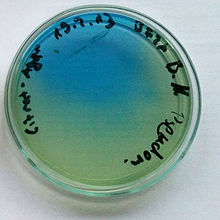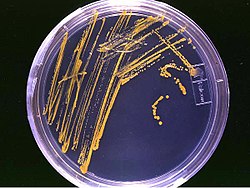Nutrient medium
A nutrient medium , as a culture medium refers to, is used for the cultivation of microorganisms , cells , tissues or small plants, such as the moss Physcomitrella patens . A distinction is made between liquid (for example broth, nutrient broth or nutrient solution ) and gelled (“solid”) nutrient media ( nutrient medium ).
application

Liquid culture media
Liquid culture media are used
- for biotechnological production processes (see bioreactor )
- for the cultivation of eukaryotic cells (see cell culture ) and microorganisms (see microorganism culture ) for research purposes
- for the cultivation of living tissues for medical use (e.g. skin transplants )
- for the detection or pre-enrichment of microorganisms (see enrichment culture )
- to test for certain metabolic activities of microorganisms for their identification (see Bunte series (laboratory) )
- for the quantification of microorganisms according to the “Most Probable Number” method (see MPN method ).
Solid culture media (gel culture media)

As Solid culture media refers to culture media, which are present by the addition of a gelling agent in the form of a gel. Solid culture media are mainly used for analysis purposes, because they also enable the quantification of microorganisms : Since the microorganisms cannot freely distribute in the medium, they form a visible colony around every microorganism on or in the culture medium when they multiply . The number of these colonies would ideally correspond to the original number of microorganisms. However, since a colony can also be formed by several individuals lying close together, the number of colonies does not correspond to the actual number of microorganisms, but only to the number of individuals and the microorganisms distributed in groups in or on the nutrient medium. These individuals and groups of individuals is referred to as CFU ( K olonie b ildende E nit, also cfu - c olony f orming u nits).
Solid nutrient media are also used if the colonies with a characteristic appearance that form on the surface of the nutrient medium gel are to be used to characterize and identify the microorganisms.
Semi-solid culture media
Semi-solid nutrient media are mainly used in test tubes as high- layer tubes , this so-called "soft agar" contains less agar than usual with a solid nutrient medium. It can be used to detect active movement through flagella ( motility ) in microorganisms . He also is establishing an oxygen gradient used microaerophilic cultivating organisms, they require a lower oxygen concentration than is present in the air.
composition
The basic composition of a nutrient medium usually consists of a main portion of water , a usable energy source for the respective organism (see chemotrophy ), for example organic compounds or compounds containing sulfur , as well as the nutrients required by it (organic or inorganic carbon , nitrogen , sulfur and phosphate - Sources as well as other essential nutrients). The nutrients are also called substrates and in the nutrient media for heterotrophs are mostly carbohydrates ("sugar"), protein hydrolyzates ( peptones ) and, if necessary, fatty acids . In addition, inorganic salts supply the organism with vital ions, such as B. ammonium , potassium , sodium , phosphate, sulfate and trace elements .
The following can also be included:
- Dyes or their precursors (microscopy dyes, chromogenic substrates)
- Gelling agents (solidifying agents), such as agar-agar or (less often) gelatin ,
- Inhibitors ( e.g. antibiotics ) and selective agents to prevent the growth of undesirable microorganisms (e.g. chloramphenicol for yeast / mold culture media)
- Indicators to show changes, such as: B. the pH value , but also to indicate certain metabolic products or metabolic activities
- Buffer substances to stabilize the pH
- Growth factors ( called supplines ) such as hormones, vitamins and the like.
To produce a nutrient medium, the nutrients and additives are mixed together according to a recipe and dissolved in distilled or demineralized water (if necessary, heated with hot, flowing steam). This is followed by sterilization (usually by heating in an autoclave ). Thermolabile additives that would be destroyed by the heat sterilization are sterilized mechanically - usually by sterile filtration with a membrane filter (sterile filter) - and added to the nutrient medium only after it has been heat-sterilized and cooled.
Solid culture media contain at least 1% agar-agar, depending on the recipe, the concentration varies between 10 and 20 g agar / l culture medium ( grams per liter ). For a so-called “soft agar” 1–4 g / l are usual. For historical reasons, aqueous solutions of complex, organic substrates are referred to as bouillon , since the first nutrient media of this type were still produced based on soup recipes. Such liquid media are similar in composition to solid nutrient media, only they do not contain agar or any other gelling agent.
Classification
Culture media can be classified according to different aspects:
According to application
| designation | Solid medium | Liquid medium |
|---|---|---|
| contains | mostly agar as a gelling agent | no gelling agent |
| application | In the case of solid media, the focus is on the isolation and analysis of the respective microorganisms, which is why they are also called isolation media. When quantifying microorganisms, solid media are used to determine the number of colonies . | Liquid media are used as an enrichment medium. They are also used when larger quantities of a culture are required. When quantifying microorganisms, liquid media are used in the titer method . |
According to ingredients
| designation | synthetic medium | complex medium |
|---|---|---|
| Explanation | They contain defined concentrations of chemically precisely defined ingredients. | This (also) contains complex, organic components that are not chemically precisely determined. |
| contains e.g. B. | D - glucose , ammonium chloride (NH 4 Cl), magnesium sulfate (MgSO 4 ), dipotassium hydrogen phosphate (K 2 HPO 4 ) | Peptone , casein hydrolyzate, yeast extract , meat extract , blood |
| application | Synthetic media are used in particular to select certain types of microorganisms. But even if identical initial conditions are important for repeat experiments, they are used. | Complex media (also called complete media) are most commonly used and allow the growth of almost all heterotrophic microorganisms. |
According to nutritional requirements
| designation | Minimal medium | Full medium |
|---|---|---|
| Explanation | It contains the absolutely necessary nutrients for the growth of the microorganism concerned (“subsistence level”), these are chemically defined. | It also contains growth-promoting substances and supplines. |
| contains e.g. B. | D -glucose as the carbon source, ammonium ions as the nitrogen source, sulfate ions as the sulfur source | Peptone or several amino acids as a nitrogen source, sulfur-containing amino acids as a sulfur source |
| application | The composition of a minimal medium must be determined empirically or known, so it is used to select and describe a certain microorganism. | Because of the growth-promoting components it contains, a complete medium is suitable for cultivating numerous microorganisms. A complex medium is also a complete medium. |
According to the workload

| designation | Ready mix | Finished medium |
|---|---|---|
| Explanation | In the case of nutrient media that are frequently used, the solid components including the gelling agent are put together industrially in order to ensure that the composition always remains the same. Such ready mixes are in the form of powder, granules , tablets or lyophilisate . | In the case of the finished medium, the medium has already been produced industrially and filled into Petri dishes or tubes. |
| application | These ready-made mixtures only have to be dissolved in heated water and sterilized if necessary . | The finished medium can be used directly without further preparation. |
According to the objective of the investigation
Media are also used to select microorganisms on the basis of certain properties. There are two approaches to this:
Selective media
Selective media only allow the growth of certain microorganisms that have special properties in order to multiply in this medium. One example is media that are fortified with antibiotics . In them, only those microorganisms can grow, in violation of the used antibiotic resistant are.
Differential media

Differential media (also called differentiation media or indicator culture media) allow the growth of several microorganisms used. However, they are composed in such a way that the resulting colonies of the various microorganisms differ from one another in appearance, so they can be differentiated. For example, bacterial strains capable of hemolysis on blood agar can be distinguished from others by the clearing zone around their colonies.
Differential media often contain dyes or pH indicators that can be used to make certain metabolic functions of the microorganisms visible. Examples of this are the breakdown of a carbohydrate by microorganisms with acid formation, in the process the pH value is lowered ( acidic ), or the breakdown of urea or citrate by bacteria; This produces alkaline degradation products, and the pH value is increased. The change in the pH value is indicated by a color change using a suitable pH indicator; this leads to discoloration of the medium or the colonies.
A well-known medium that combines both of these principles is MacConkey agar . It contains bile salts and crystal violet and thus prevents the growth of gram-positive bacteria and thus acts as a selective medium. Lactose and neutral red are included for its effect as a differential medium , so that lactose-fermenting bacteria can be identified by means of a color change in the pH indicator neutral red. Another frequently used culture medium that acts both as a selective medium and as a differential medium is XLD agar .
Replica plating
Replica Plating (German to about Replikationsausplattierung ) denotes the transfer of all the colonies from a solid nutrient medium to another solid medium to obtain the arrangement of the individual colonies to each other. For this purpose, a sterile velvet cloth is stretched overa Lederberg stamp , which is first transferred to a plate overgrown with colonies and then onto a non-overgrown plate by gently pressing it on. The imprint creates a copy of the colonies on the solid nutrient medium, which is cultivated for the colonies to grow. The pile fibers of the velvet prevent the colonies from smearing. Before using velvet, colonies were transferred with sterile toothpicks (according to E. Tatum) or with sterile filter paper (according to N. Visconti).
Individual evidence
- ↑ Birgit Hadeler, Sirkka Scholz, Ralf Reski (1995) Gelrite and agar differently influence cytokinin- sensitivity of a moss. Journal of Plant Physiology 146, 369-371.
- ↑ a b c d e f Eckhard Bast: Microbiological methods: An introduction to basic work techniques . 2nd Edition. Spektrum Akademischer Verlag GmbH, Heidelberg / Berlin 2001, ISBN 978-3-8274-1072-6 .
- ↑ a b c Roland Süßmuth, Jürgen Eberspächer, Rainer Haag, Wolfgang Springer: Biochemical-microbiological internship . 1st edition. Thieme Verlag, Stuttgart / New York 1987, ISBN 3-13-685901-4 , p. 12-15 .
- ↑ J. Lederberg , EM Lederberg: Replica plating and indirect selection of bacterial mutants. In: J Bacteriol. (1952), Vol. 63 (3), pp. 399-406. PMID 14927572 ; PMC 169282 (free full text).
Web links
- Media Index for BAM (list of culture media in the Bacteriological Analytical Manual). In: US Food and Drug Administration (FDA) website . March 16, 2013, accessed April 2, 2013 .


